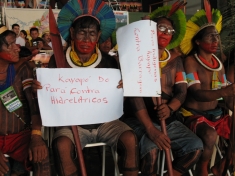Critical Encounter Moving Forward
Photo by Glenn SwitkesThe Xingu Encounter 2008 has already helped to place international attention and pressure on the Brazilian government, which is being criticized for prioritizing economic growth over protection and preservation of its fragile environment and even human life. Indigenous groups have traveled from all over the Amazon to convene in Altamira, and there is a fantastic energy emerging from this unification of ideas and actions. The Encounter provides them with the opportunity to educate the world and garner international support in protest of the government-sanctioned projects. Additionally, these five days are critically important because they will cause the Brazilian government to pay attention to the needs of its people.
Scores of studies detailing the disastrous effects of the proposed Belo Monte Dam project have been presented to government officials already. This project alone would cause more than 500 of them to abandon their homes and land, as well as bid farewell to the abundance of natural resources that the river now provides for them. "This government sees environmental licensing as a mere bureaucratic process. They don't really care what the impact study shows," says Marco Antonio Delfino, an Altamira public prosecutor (Reuters). The hope is, however, that the next couple of days and the events that ensue in the Amazon will weigh heavily on the government's conscience so that they will really address the negative impacts that the project will create and make the correct, critical decision. Belo Monte Dam is "going to be the most inefficient dam in the world," says Glenn Switkes of International Rivers (Reuters), and it would also flood 170 square miles and divert part of the Xingu River, which flows to the Amazon.



